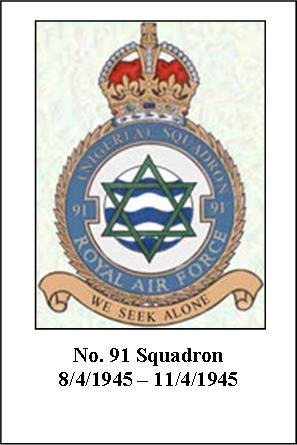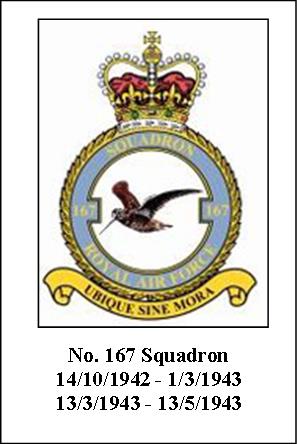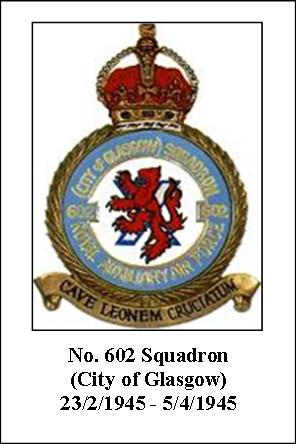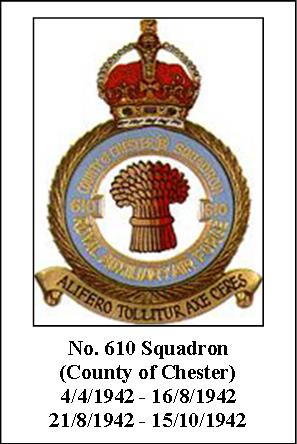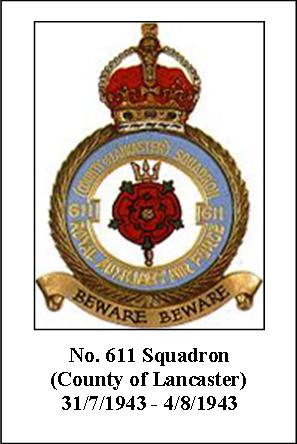|
|
|
|
Chapter
5
The World War II Years -
Ludham Airfield
Ludham War Memorial
|
By - Squadron Leader H. H.
Woolley MBE, RAF (Retired)
During the build-up towards a threatened war in Europe an
airfield for air defence fighter aircraft had been
established in 1939 close to the village of Coltishall and
had proved to be invaluable during the Battle of Britain.
After two years of operating fighter aircraft from
Coltishall in a purely defensive role, the Air Ministry
decided that the squadrons based there should extend their
range of operations to cover the North Sea, with the aim
of providing air cover for British convoys and the
surveillance and attack of German coastal shipping as far
away as the Dutch and Belgian coasts, and by building a
satellite airfield even nearer to the coast, the extra
range obtained would allow aircraft to stay longer in the
operating area.
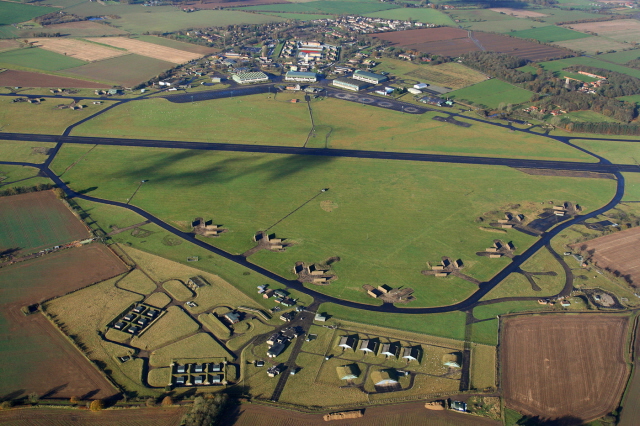 RAF Coltishall
RAF Coltishall
So, an area to the north east of Ludham was surveyed and
work commenced in the autumn of 1941 by the main
contractor, Richard Costain Ltd. Whereas Coltishall was a
grass airfield, Ludham was built with concrete runways and
perimeter tracks because of the marshy land around it.
This led to it becoming one of the best operational fields
in the area, and a favourite for the operational aircrews.
Indeed it proved to be the nearest British airfield to the
continent, and the first one that bombers returning from
raids on Germany could land at if they were badly damaged.
Construction of the basic airfield was completed in
November 1941 and, on 20th of that month, six Spitfire Mk
llA aircraft of No152 Squadron were deployed to Ludham on
a daily basis from RAF Swanton Morley for convoy patrols
off the Norfolk coast and to provide escorts for bombers
as far as Holland.
During the construction of the airfield, the Germans had
two attempts to destroy it, with no success except for a
few broken windows. On the first occasion three bombs were
dropped in the field between Gipsies Lane and the Catfield
Road, and in the second raid seven bombs were dropped at
the Potter Heigham end, missing the airfield and landing
close to Bethel Cottages beside what was then the A149
road.

Immediately the airfield itself was completed, work was
rushed through to finish the domestic and administration
accommodation, which consisted mainly of nissen and
prefabricated huts, set in six groups on the western side
of the airfield, whilst technical accommodation in the
form of blister hangars and protective pens were situated
on the south and west sides of the airfield.
To give some idea of the layout of RAF Ludham, the
airfield itself consisted of three concrete runways
forming an isosceles triangle, thus providing the ability
for aircraft to take off and land within thirty degrees of
the prevailing wind. The runways were connected by a
perimeter track to which the hangers and dispersals, with
their protective revetments had access. On the east side
of the airfield the dominant feature was the high walls of
the machine gun and cannon range, where the eight guns in
the Spitfires wings were aligned, so as to provide an
accurate aiming point for the pilot.

|
Next to this was a small shooting
range for target practice by the defence force and
sleeping accommodation for the guards. Around the
perimeter of the airfield the army had a series of
gun platforms holding searchlights and Bofors
anti-aircraft guns. On the west side, next to
taxiway was the Watch Office, a single storied hut
from which the air activity on and around the
airfield was controlled. Close to this were the
Station Headquarters, the main workshops and the
aircrew briefing rooms. |
Further west, across the Catfield
Road were six accommodation areas, one for the
WAAF with its own cookhouse (dining room) and
NAAFI, one for sick quarters, dental services, the
Officers Mess and dining rooms for all ranks. The
other sites housed the airmen and Non Commissioned
Officers. Site No 8 provided the sewage works for
the station and is still in use today, with
updated equipment (See airfield map later in
chapter).
Photograph: Courtesy of Alan J. Foster
The original Watch Office (control tower) |

|
Very soon the airfield was fully operational to undertake
its primary tasks of bomber escort and North Sea
patrolling. The construction work must have been completed
in record time as the first permanent Squadron, No. 19
Sqn, equipped with Spitfire Mk5b aircraft flew in from
Coltishall’s other satellite airfield at Matlaske on 1st
December 1941. As mentioned before, the concrete runways
were greatly appreciated by the pilots and one pilot from
19Sqn. was quoted as saying that Ludham was “… mainly of a
large area of mud with taxiways and runways in the middle
of it, and weather which was mainly cold and damp. At
least we had runways!”

|
No. 19 Sqn remained at Ludham until
4th April 1942. During its stay here it had shot
down a number of German bombers, the first being a
Dornier off the coast near the Happisburgh light
ship. The squadron was replaced by No 610 (County
of Cheshire) Squadron, flying Spitfire Mk5b
aircraft, which took over a similar task to that
of its predecessor.
Picture - Supermarine Spitfire Mk 2
|

|
Although the squadron had taken
part in a number of operations, its first success
whilst at Ludham was on 27th April when it
intercepted and shot down a German bomber over the
sea between Lowestoft and Yarmouth. On the same
day the Germans started their first ‘Baedecker’
night bombing raid on Norwich and during this raid
the squadron put up ten aircraft, but had no
success. It must be remembered that the Spitfire
was a single seat day fighter without any
specialist night operating equipment. Its only
assistance was from the recently opened radar
station at Royal Air Force Neatishead, sited near
the village of Horning. Although the radar could
‘see’ the bombers and the fighters, and the
controllers could vector the fighters to within a
close distance of their targets, the pilots had
then to see and identify their targets, aim and
fire within a matter of a few seconds. In the dark
it is a very difficult task to see, let alone
identify, a target. |
The next German bombing raid on Norwich was on 29th April,
again around midnight, and again 610 Sqn reacted, putting
up eight aircraft. Enemy bombers were seen in the glare of
the fires started by the German bombs, but the pilots lost
them in the smoke from the fires. The following night the
squadron was again scrambled to over Norwich, but no enemy
was sighted. However an enemy bomber was seen in a
searchlight beam and intercepted by an aircraft from RAF
Coltishall.
Little air activity was then reported until the middle of
May when a flight of No.610 Sqn Spitfires spotted and
attacked a German bomber off the Norfolk coast and shot it
down. The following evening (16th) two spitfires took off
from Ludham to patrol along the Norfolk coast. They
spotted a German bomber approaching a British convoy and
attacked it head-on, and shot it down. In June a similar
pattern emerged, occasional skirmishes with enemy bombers,
with some successes but also with the loss of some allied
pilots. (No 610 Sqn, like many others, was composed of
pilots of many nationalities – British, Free French,
Canadian, Australian, Czech and Belgian).
| In October 1942, 610 Sqn was
replaced by No. 167 (Gold Coast) Squadron again
flying Spitfire aircraft. This squadron was well
trained in escort duties, both for bombers and
shipping convoys and the threat from enemy raids
was now diminishing. Having said that, a German
bomber did fly over Ludham at very low level on
3rd November. Unfortunately the air raid warning
system was faulty, the anti-aircraft guns had
their covers on because of heavy rain, and the
gunners had insufficient warning. A couple of time
bombs were dropped in the local area, but no
damage was done. |

|
Incidentally, Mervyn Hinton, in his excellent memoirs (A
Short History and Personal Reminiscences of Royal Air
Force Ludham Air Field) describes an incident when an
enemy bomber was shot down by the airfield defence force.
An alert came over the field telephone that a lone German
bomber was returning from a daylight raid on Norwich. One
gun on the Potter Heigham side of the airfield opened fire
at it followed by a second gun. The army gunners were
successful and the bomber crashed into the sea off Sea
Palling. In another incident, this time at night, a German
bomber was trapped in the beam of a Ludham searchlight,
and the guns naturally opened fire. However the bomber
retaliated, and the searchlight was extinguished by the
rear gunner of the bomber. It was rumoured that a bullet
passed through the gunner’s trouser leg, without touching
his flesh. His only damage was a loss of voice for a few
days!.
Photograph by courtesy of Mervyn
Hinton
The Air Traffic Control tower, now in a dilapidated
state.
It was near to the end of 1942 that the old Watch Office
was replaced by a new Air Traffic Control Tower, the
remains of which we can see today. The airfield
controllers were on the upper floor, with excellent views
across the field, whilst the ground floor housed radio and
communications equipment and the meteorology section.
No. 167 Sqn carried out a number of reconnaissance
missions during the latter half of October and by the end
of the year had participated in a series of successful low
level raids over Holland, known as ‘Rhubarbs’; and also
preformed escort duties for bombers.
1943 started in excellent fashion when on Thursday 28th
January King George Vl and Queen Elizabeth visited RAF
Ludham. Coinciding with their arrival, two Spitfires of No
167 Sqn were scrambled to intercept a German light bomber
that was harassing a convoy near to the Norfolk coast. In
nine minutes the fighter leader had sighted and shot down
the bomber in the sea off Yarmouth, and returned to base.
It was the leader’s first ‘kill’ and he celebrated it with
a victory roll over the airfield. Naturally the King and
Queen were delighted, and insisted on meeting the heroes
of the moment in the Officers Mess where they were joined
by the rest of the squadron personnel over a cup of tea.

|
The first few months of 1943 were
spent escorting light and medium bombers over the
North Sea to give them protection from the German
fighters, and the occasional aggressive strike on
enemy installations in Holland. Then, in the early
afternoon of 17th April, the Squadron took off to
meet and escort home more than sixty B17 ‘Flying
Fortress’ bombers of the United States Air Force
returning from a raid on a German port and guided
them safely over the Norfolk coast before landing
back at Ludham. |
Then in the early evening they were airborne again to
escort light bombers over to Holland to bomb German
shipping in Zeebrugge harbour. The next day was spent
escorting bombers on an attack of shipping off the Dutch
coast. This was followed two days later by more escort
duties to the continent. These were typical days in the
lives of escort pilots, which is one reason for changing
the squadrons over at regular intervals. Another reason
was given too; it was to stop the handsome young pilots
running off with all the young ladies of the surrounding
villages!

|
On 13th May 1943, the squadron was
redeployed to Lincolnshire and was replaced at
Ludham by No 195 Squadron which flew Hawker
Typhoons. This move had been necessitated by a new
threat, constant hit and run raids by German
fighter-bombers on the Norfolk and Suffolk coast.
The Typhoons had a greater amount of firepower
than the Spitfire and were therefore more lethal
against the heavily armoured German raiders. This
was the first time there had been no Spitfires
based at Ludham. Two days after their arrival a
flight of Typhoons on patrol spotted German
bombers attacking a bomber airfield in North
Norfolk, and shot one down as it crossed over the
coast. The Typhoon was a new type of aircraft and
was suffering from ‘teething troubles’. |
Aircraft un-serviceability was reducing No 195 Sqn’s
ability to accomplish all its tasks, and so to reinforce
it, No 245 Sqn, also flying Typhoons, was transferred to
Ludham from Matlaske, Coltishall’s other satellite
airfield, and was immediately in action, flying four
patrols per day. It continued in a similar pattern,
interspersed with low-level attacks on German assets in
Holland and Belgium until mid July, when bomb racks were
fitted under the wings of the Typhoons, and a programme of
low level bombing training was commenced.
| After only six weeks at RAF
Ludham, on 31st July the Typhoons were sent back
to Matlaske and Ludham was again home to
Spitfires, this time belonging to No.611 (County
of Lancaster) Sqn. They only remained for five
days, but completed two missions, the second of
which resulted in the bombers they were escorting
sinking some enemy shipping. The squadron moved
across to RAF Coltishall, and Ludham was handed
over to the Ministry of Works for them to prepare
the airfield for the United States Air Force, who
were planning to move in a squadron of B17
bombers. As is normal in warfare, plans were
changed, and work was put into abeyance. Although
the airfield was non-operational, the control
tower was manned by staff from Coltishall, and
became a home for damaged aircraft returning from
raids over Germany. In all, eight B-17’s, one
P-47, one P-38 and one B-24 crash landed here.
Apart from these incidents, the airfield was not
used, and the Air Ministry handed it over to the
Royal Navy, who christened it H.M.S. Flycatcher
and established it as the Headquarters of Mobile
Naval Airfields Organisation (MNAO) |

|
During its stay, the MNAO established five mobile airbases
and a transportable maintenance yard which were all
shipped to Australia to participate in the war in the Far
East against the Japanese. Their work completed , the Navy
‘abandoned ship’ on 16th February 1945 and the station was
handed back to the Royal Air Force.

|
No 602 (City of Glasgow) Sqn moved
in with Spitfires, followed the next day by No 603
(City of Edinburgh) Sqn., tasked with armed
reconnaissance of the new V-1 and V-2 sites in
Holland and dive bombing them when the opportunity
occurred. A large number of sorties were flown by
both squadrons and the main interest appeared to
be shooting-up motor transport on the Dutch roads.
On 5th April No 602 Sqn was ordered to fly to
Coltishall and on 23rd No.603 also moved over at
the same time. Then, on 8th April No 91 Sqn
arrived, with 18 Spitfires with the task of
carrying out armed reconnaissance missions and
anti submarine patrols off the Dutch coast. This
work was carried on until 1st May, and from then
on the only flying was training sorties. No 1 Sqn
was transferred from Coltishall to Ludham on 14th |
May, but by then the land war in Europe had moved
too far east and out of operational range of the Spitfire.
On 8th May VE (Victory in Europe) was announced and the
airfield began to run down. The last squadron, No1, left
on 20th July 1945.
Ludham airfield, which for four war torn years had been
home to Spitfires, perhaps the most famous fighter
aircraft in the world, was silent at last. Many pilots had
lost their lives during those years. They have not been
mentioned here, but anyone interested can read the details
of operations and general activities in Alan J. Foster’s
well researched book Airfield Focus.
However, the airfield refused to die! Although much of the
runways, taxiways and hard-standings were broken up and
used as hardcore there was a small part of the east/west
runway left. In the mid 60’s this was utilised by Mr Peter
Boardman who owned a De Havilland Hornet Moth, a
delightful small private plane, in which he would fly over
to the Continent for pleasure. Then the North Norfolk
District Council authorised it for use by the Westwick
fleet of crop spraying light aircraft; they used a 600
yard strip of tarmac, and the council in its wisdom
allowed them to move a wartime hanger from one of the
dispersals, providing that it was re-erected on the end of
the strip of tarmac! This of course was right in the path
of aircraft taking off and landing –like building a garage
in the middle of a motorway. Despite this hazard, the
airfield was adequate for the task and when they moved
out, private light aircraft owners made it a base.
Then, to complete the circle, Spitfires came back. Towards
the end of 1985 Ralph Hull, an aircraft engineer who had
served with the Army Air Corp in Borneo, and with Air
Canada, had a burning ambition to rebuild a wrecked
Spitfire and turn it into a flying example of the great
aircraft.
Spitfire TE 566 takes to the skies
again
He rented part of the hangar from a four-man syndicate who
had just purchased the old airfield, and started work. He
had obtained the wreck of a Spitfire Mark 9 from the
Israeli Air Force, (it had ended its days in a children’s
playing field) who, in turn had bought it from the Czech
Air Force. It had originally been in service with a Czech
Air Force Squadron (No 312 Sqn) based at Coltishall, and
still bore its original RAF serial number TE 566. At the
end of hostilities the squadron had returned to their
liberated country with their aircraft, and it had been the
first Spitfire to fly over their capital. After years of
patient work it was finally rolled out of the hanger.
Regretfully it did not fly from Ludham, but was taken to
Audley End for flight testing. In the meantime Ralph had
acquired another wreck of a Spitfire, and was back to
work. Eventually the work overflowed, and Ralph moved to
larger premises at Catfield in 1993.
Whilst working on the airfield, Ralph encountered some
strange phenomena. Whilst working in the late evenings he
would smell cigarette smoke and hear occasional whistling,
even on a windless night. Of the latter, he remarked that
if one told the whistler to “Shut up” it stopped.
Sometimes a sudden chill would sweep through the hangar.
Perhaps there are some whose war has not yet ended.
Map Of Ludham Airfield
SOME OF THE BADGES OF
THE SQUADRONS BASED AT
ROYAL AIR FORCE LUDHAM DURING THE 1939 – 1945 WAR
|
|
|


















